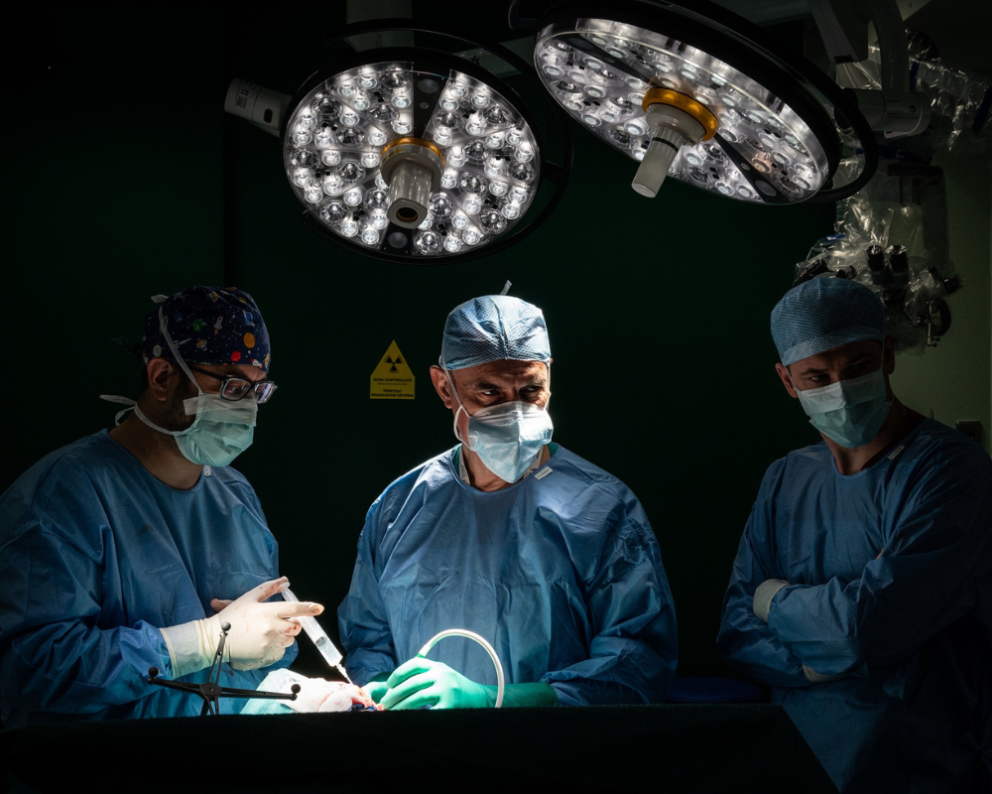Published results of world's first patients implanted with spinal cord neurostimulator

New hopes for motor recovery and reduced spasticity thanks to the high frequency stimulation protocol. The study published in Science Translational Medicine has been signed by doctors and researchers from the IRCCS San Raffaele Hospital, Vita-Salute San Raffaele University and Sant'Anna School of Advanced Studies
A team of physicians and researchers from the IRCCS San Raffaele Hospital in Milan and Vita-Salute San Raffaele University (UniSR) and bioengineers from the Sant'Anna School of Advanced Studies, has obtained promising results in the treatment of spinal cord injuries, thanks to an innovative high frequency epidural electrical stimulation protocol. The study, published in Science Translational Medicine, demonstrated that this technique significantly reduces muscle spasticity and improves motor skills in patients with spinal cord injuries.
The research focused on the first two patients with incomplete spinal cord injuries, who in 2023, thanks to the implantation of the spinal cord neurostimulator, a device already in use in pain therapy, recovered their motor functions. The researchers applied targeted high-frequency stimulations that, combined with rehabilitation, significantly improved muscle strength, walking and motor control. The stimulation protocol applied also reduced the pathological reflexes and involuntary muscle contractions underlying muscle spasticity, favouring more fluid and natural movements.
Muscle spasticity
Central nervous system diseases such as multiple sclerosis, or traumatic spinal cord injuries that interrupt communication with the brain, can cause difficulty walking, paralysis of the limbs and muscle spasticity. The latter is the intermittent or sustained activation of muscle contraction and leads to stiffness and involuntary spasms of the muscles, significantly reducing the mobility of affected people. Muscle spasticity affects nearly 70% of spinal cord injury patients, and recent studies have shown that electrically stimulating an injured spinal cord is a promising strategy for restoring the ability to walk. Low-frequency stimulation protocols are currently applied to mitigate spasticity, but they have a limited effect in patients suffering from muscle spasms.
The study
The patients examined in this study both had a traumatic spinal cord lesion and during 2023 they underwent an innovative operation involving the implantation of a spinal cord electrostimulator which allowed them to walk again, after a long rehabilitation process at the unit directed by Dr. Sandro Iannaccone. At the end of the course, both patients showed significant improvements in their functional abilities, with one of them walking 175 meters without active stimulation.
The patients involved in this study participated in an intensive rehabilitation program, which integrated low and high frequency stimulation with motor exercises. The research team then observed that high-frequency stimulation of the spinal cord is a safe way to inhibit pathological hyperreactivity of spinal circuits without generating discomfort in patients.
«The spinal cord is naturally hyperresponsive to stimuli, which is necessary to promote normal rapid reflexes. This hyperreactivity is usually balanced by the brain, which inhibits motor circuits when their activation is not required. However, in the case of spinal cord injury, the patient loses the inhibitory messages coming from the brain that regulate spinal hyperreactivity - explains Simone Romeni, first author of the study and researcher at the Ecole Polytechnique Federale de Lausanne (EPFL) and the IRCCS Hospital San Raffaele, who continues - We therefore believe that stimulation at frequencies in the kiloHertz range (much higher than those used in previous studies), applied in our protocol, interferes with this spinal hyperactivity pathological, inhibiting its transmission to the muscles and consequently reducing spasms».
Conclusions
«The spinal stimulation protocol developed and tested in this study represents a significant example of the extraordinary potential of neuroengineering applied to neurorehabilitation. This first result, born from the precious collaboration with colleagues at San Raffaele, lays the foundations for the future development of new technological solutions, aimed at improving the quality of life of people with motor disabilities and enhancing the therapeutic opportunities available», explains Silvestro Micera, professor at EPFL and Sant'Anna School of Advanced Studies and coordinator of the study.
«To date, 8 patients have been treated with the neurostimulator. This is a safe and effective surgical procedure that offers a new perspective in the treatment of patients with severe damage to the spinal cord. The combination of advanced technologies and personalized approaches to rehabilitation offers new perspectives for motor recovery, revolutionizing the treatment of spinal injuries, reducing the side effects associated with currently available pharmacological and surgical therapies», adds Pietro Mortini, Professor of Neurosurgery at UniSR, head of Neurosurgery at the IRCCS San Raffaele Hospital and also coordinator of the study.
«Next steps will include further clinical studies on a larger number of patients to confirm these preliminary results. We are planning to extend the indications to several clinical conditions that we will define in the coming months. We are at the beginning of a new, promising era for motor neurorehabilitation. We particularly intend to express our profound gratitude to the patients who have placed their trust in us», concludes Professor Mortini.
You might be interested in

The microbiome as an ally against myeloma

Intrecci: a UniSR project for more inclusive and accessible cancer diagnosis

A New Approach to Enhance Immunotherapy in Multiple Myeloma
/resolutions/res-c660x528/Pensa_Aorta_Congresso_UniSR-(3).png)
